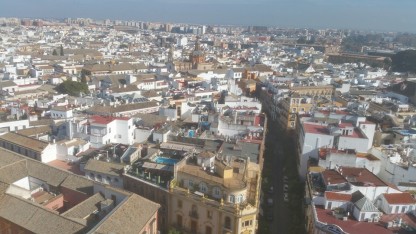
Marianys Marte explores how Seville, Spain’s history has impacted culture in the Greco-Roman city. (Marianys Marte/The Fordham Ram)
By Marianys Marte
SEVILLE — Studying abroad has always been my dream, and now that I’ve been in Spain for almost two months, that dream has become a reality. My desire to spend a semester abroad brought me to the city of Seville in southern Spain. During my first two weeks here, I learned more about the history of this country than I ever expected to through my cultural history of Spain class. As part of my program, Council on International Educational Exchange (CIEE) Seville, I had to take an intensive session course. The class was half lecture and half field trips around the city. As a Communications major, I have been taught that everywhere you look there is a story to tell. In Seville, there are hundreds of stories. On the first day of class, I visited Roman ruins that are down the street from our classroom. As I was face to face with the remains of a Roman temple, I could only imagine the stories it would tell.
Through this class, I was able to see Spain for what it is. Its plural identity is determined by different historical circumstances, making it is a beautiful and complex mosaic of cultures. The Phoenicians, Carthaginians and Romans were all attracted to Spain for different reasons, and they left their marks on the society. On my walk to class, I pass by numerous churches that were once mosques. After my class, I can see how the minarets were turned into bell towers and how columns were integrated into these magnificent structures.
The purpose of this class was to help international students understand the historical evolution of Spain. The chronological analysis of the culture led us to explore the most important moments in this country’s history, which provided me with a certain global vision of the events that marked the evolution of Spain. It was the perfect class to take while I was settling into a new place.
As part of the class, we also had outside visits that we needed to do on our own time. This was the perfect excuse to learn how to navigate the city. I was assigned to visit the Basilica of la Macarena, which is a place I would not have found had it not been for this class. To this day, it is one of my favorite places in Seville. I was able to study the architecture of the building and after my visit, to present my findings to the class. Thanks to this course, I learned how to distinguish each building in Seville and pick out which ones belonged to which culture.
My professor has been teaching at CIEE for over a decade, yet still has a passion for teaching and acts like it’s his first year on the job. He is a top-notch historian who answered any questions I had about the history of Spain. Through Professor de Quinta I was able to learn things that most Spaniards do not even know about their own history. He gave me an inside look on the culture and made the assimilation process much smoother during those crucial first two weeks.
